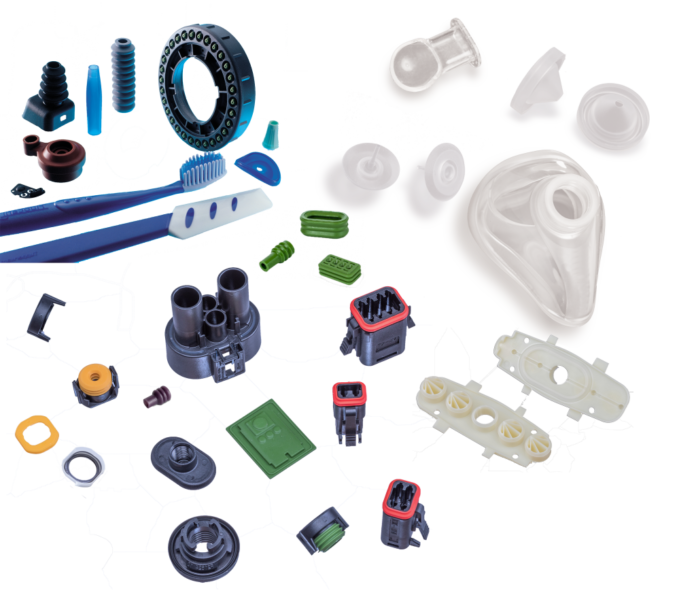Liquid Silicone Rubber (LSR) injection molding is a rapidly growing manufacturing technique for creating high-quality, intricate silicone parts. This versatile process offers numerous advantages over traditional methods, making it a valuable tool for a wide range of industries. This comprehensive guide delves into the world of LSR injection molding, explaining its core principles, applications, and the benefits it provides.
Understanding Liquid Silicone Rubber (LSR)
LSR, also known as Liquid Silicone Elastomer, is a type of silicone rubber that exists in a liquid state before undergoing a curing process. This unique characteristic makes it ideal for injection molding, allowing for precise shaping and mass production. LSR boasts a remarkable combination of properties, including:
- Biocompatibility: Safe for contact with human skin and tissue, making it suitable for medical devices and baby products.
- Durability: Offers excellent resistance to UV rays, ozone, and extreme temperatures.
- Flexibility: Maintains its elasticity within a wide temperature range.
- Chemical Resistance: Inert to many chemicals and oils.
- High Tear Strength: Resists ripping and tearing.
- Dimensional Stability: Retains its shape well after molding.
The LSR Injection Molding Process: A Step-by-Step Breakdown
LSR injection molding involves meticulously controlled steps to ensure consistent, high-quality part production. Here’s a breakdown of the key stages:
- Mold Design and Manufacturing: A crucial first step is designing a mold that precisely replicates the desired part geometry. LSR molds are typically crafted from steel or aluminum to withstand the pressure and heat involved in the process.
- Material Preparation: LSR comes in two separate parts: base (A-side) and catalyst (B-side). These components are stored in dedicated containers and maintained at controlled temperatures for optimal processing.
- Metering and Mixing: During injection, precise metering pumps accurately measure the required amounts of A and B components. These components are then mixed thoroughly within the machine’s mixing unit to initiate the curing reaction.
- Injection and Mold Clamping: The mixed LSR is injected into the closed mold cavity under high pressure. The mold remains clamped shut to ensure the LSR fills all cavities and maintains its shape during curing.
- Curing: Heat and pressure are applied within the mold to accelerate the LSR’s curing process. Curing times can vary depending on the part thickness and complexity.
- Part Ejection and Finishing: Once cured, the mold opens, and the finished silicone part is ejected. Depending on the application, parts may undergo additional processes like trimming or surface treatments.
Advantages of LSR Injection Molding
LSR injection molding offers a multitude of benefits compared to other silicone part manufacturing techniques:
- High Precision and Repeatability: The controlled injection process allows for consistent part dimensions and intricate detail replication.
- Mass Production: LSR injection molding is well-suited for high-volume production runs, ensuring efficient and cost-effective manufacturing.
- Minimal Flashing: The controlled nature of injection molding minimizes excess material (flash) formation, reducing finishing requirements.
- Automation Potential: The process is highly automatable, leading to increased production efficiency and reduced labor costs.
- Wide Material Selection: A diverse range of LSR formulations are available to cater to specific application requirements, such as varying hardness, color, and flame retardancy.
- Short Cycle Times: Compared to traditional methods, lsr injection molding offers faster cycle times, leading to quicker production turnaround.
Applications of LSR Injection Molded Parts
The versatility of LSR and the precision of the injection molding process make it a valuable tool across numerous industries. Here are some prominent applications of LSR injection molded parts:
- Medical Devices: Components like valves, seals, gaskets, and tubing for medical instruments and equipment.
- Consumer Electronics: Keypads, buttons, seals, and protective components for electronic devices.
- Automotive: Gaskets, seals, and vibration dampeners for various automotive applications.
- Baby Products: Nipples, teethers, and other soft components for baby bottles and toys.
- Household Appliances: Seals, gaskets, and vibration dampeners in appliances like dishwashers and washing machines.
- Food and Beverage: Seals, gaskets, and valves for food processing equipment.
Conclusion: LSR Injection Molding – A Pioneering Manufacturing Technique
LSR injection molding has revolutionized the production of high-precision silicone parts. Its unique combination of material properties, process control, and versatility makes it an attractive option for a wide range of industries. As technology continues to advance, LSR injection molding is poised to play an even greater role in shaping the future of silicone part manufacturing.
